I rarely go anywhere without my Canon 7D* SLR camera. I take it to work, I take it to restaurants, I take it to conferences, I take it on vacations and I take it on hikes. My poor 7D has been washed by rain, fallen off a table, smacked into walls, showered in sauce, and showered with water off the back of a dog. It's a solid imaging device. The photos look great, the battery lasts forever, and it takes a beating without complaining. I often have a handful of lenses with me too. I don't see the point of owning a nice camera and lens and then leaving them at home.
 |
| Look at that NEX-6 sky |
So when it seemed time to upgrade, why wouldn't I want to replace it with a similar camera with improved specs? You can listen to my thinking on the Lean Decisions Podcast. The summary: I suspected that there were some new kinds of cameras out there which would improve my life and my shooting far more than some fundamental imaging improvements.
The Future of Cameras
At this moment, the best tools for photography are converging from two directions. On one side, smart phones and tablets featuring offering better and better small-sensor cameras, apps for editing the photos they take, and apps for uploading and sharing those photos quickly. The image quality doesn't compare technically with dSLRs or other devices with larger sensors, but they are incredibly convenient. The quality of photos from a nice smart phone is often more than good enough. I'm often caught taking photos with my third generation iPad, which produces impressive images for the tiny size of its camera.
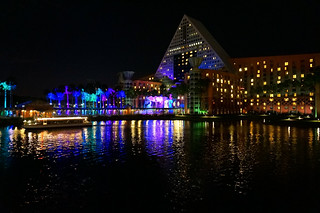 |
| Shooting the NEX-6 outdoors at night |
On the other side, technology from dSLRs is getting crammed into smaller and smaller cameras. Even lenses are getting smaller without sacrificing quality. On-camera editing and wireless transmission are more and more common on new devices. Some dSLRs like the Canon 6D even now can be remotely controlled by smart phones and tablets.
I think the Sony NEX-6 lies very close to the convergence of the smart phone cameras and the old-school dSLR. The NEX-6 has a dSLR-class sensor, interchangeable lenses, a viewfinder, and enables critical professional functionality like aperture-priority, shutter priority, manual exposure, and manual focus. Like a smart phone, the NEX-6 has WiFi and runs apps that enhance or change its functionality. Note that only Sony can write the apps for the camera.
 |
| Handheld in candle light & difficult shadows? Not hard to fix with the NEX-6 RAW files. |
Cameras that makes it easier to get a photo from idea to published will make photographers significantly more productive. When a pro uses a dSLR, the camera works hard to minimize the difficulty of capturing an outstanding image. Expensive cameras are judged by how well they enable a user to capture the images they want in different situations.
Capturing the image is only half the job though. Photographers still generally need to review their photos, edit them, and get them published. In the future, I suspect that we'll judge expensive cameras by how easily and rapidly they enable photographers to get images through the entire pipeline. Photos that don't reach an audience don't help the photographer.
In my mind, the idea camera will cause folks to bug the photographer with questions about how they make so many beautiful photos so quickly.
EVIL Cameras
There is a new class of cameras some have called EVIL: Electronic Viewfinder Interchangeable Lens. These are cameras which have no optical viewfinder, no mirror, and are typically much smaller than their SLR counterparts. Without a viewfinder prism and space for a swinging mirror, the size of a camera can be reduced significantly. Two of these EVIL cameras stood out to me as potential replacements and improvements on my Canon 7D.
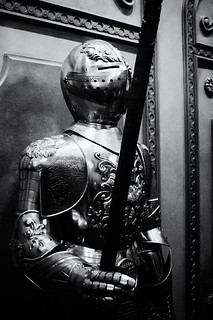 |
| Detail on a NEX-6 at ISO 3200 |
The first camera I considered was the Olympus OMD EM-5. This camera received lots of attention from prominent photographers I follow. +Scott Bourne has fallen in love with this Micro Four Thirds format camera. The OMD has an electronic viewfinder, an articulated touch-screen on the back, and is splash-proof when used with similarly weather-proofed lenses. It also has in-body image stabilization. I've leaned a lot by listening to Scott, so I listen to his opinion.
The second camera that caught my eye was the Sony NEX-6, a camera which uses Sony's proprietary E-mount for lenses. The NEX-6 is a similar size to the Olympus OMD EM-5, but has a APS-C sized sensor that's actually just a tad bigger than the one in my Canon 7D. The NEX-6 is positioned in the Sony lineup just below the NEX-7 which +Trey Ratcliff has spoken highly of. The NEX-6 takes things one step further than the OMD by adding WiFi and support to download (Sony developed) apps which add capabilities to the camera. Unlike the OMD, the NEX-6 isn't ruggedized against water.
Comparing the NEX-6 and the OMD
Both the NEX-6 and OMD seem to be fine cameras. My friend +Peter Tsai has an OMD and loves it. I tried it for a few minutes and I was super-impressed with the low-light image quality and the image stabilization. The OMD is awesome.
 |
| The NEX-6 RAW file dynamic range - no HDR processing |
The NEX-6 stacks up pretty poorly in some respects against the OMD. The OMD has several features that I covet:
- In-body image stabilization that works with many lenses
- A large library of lenses which are generally smaller in size than those for the NEX E-mount.
- Weather sealing
- A long-exposure bulb mode that lets you watch the image develop before the exposure completes
- Touch to focus and shoot on the rear touch screen
I purchased the NEX-6 instead for a few reasons:
- The functionality of the NEX-6 can be extended with apps
- Smart phones can control the NEX-6 and retrieve images off of the camera
- The NEX-6 offers focus peaking which helps with manually focusing a lens
- The NEX-6 offers a wider field of view given the same focal-length lens
- There are third-party adapters for the NEX that allow Canon and other third-party lenses to be used with it
- The NEX-6 looks a shade less conspicuous than the OMD, which some folks might still call a "professional" camera because of the SLR-like styling
Of all those items, three were important for my personal consideration. First, I often like capturing a wide-angle view. Given a particular focal length, the sensor size of the OMD offers a view with about a 2X zoom factor compared to a full frame sensor. The NEX-6 crop sensor has a wider 1.5X zoom factor compared to a full frame sensor. I'm not aware of lenses for Micro Four-Thirds cameras that offer as wide of view as those available for crop-sensor cameras.
Secondly, the more wide availability of third-party lens adapters for the NEX-6 make it more attractive since I can make use of my tiny library of Canon EOS glass. Lenses are the most expensive part of any camera system, so the ability to continue using my old lenses helps a lot on cost.
Finally, the ability to add functionality to the camera through apps really interests me. I'm a mobile app developer, so I definitely believe in the power of apps to make devices better.
First Impressions of the NEX-6
I developed a good solid two weeks of use from my NEX-6 when I started writing this review. I received it right before the winter holidays, and it accompanied me to Tampa, Orlando, and New Orleans. During that time, it went to two theme parks, many restaurants, a few bars, a steam-powered river boat, on a night-time ghost tour, and on the beach.
A few aspects of the camera immediately stood out to me. First, the thing does an amazing job of capturing detail in the sky while still exposing the rest of a scene well. The dynamic range in it's photos really impresses me. A single RAW file can make a pretty striking HDR image with minimal processing. I made this photo of the Haunted Mansion below with one RAW file. I purposefully darkened the exposure for a ominous atmosphere, but I could have easily made it look bright as day despite the back-lit scene. I kept the default noise reduction settings from Lightroom 4 and Nik Color Efex Pro 2.
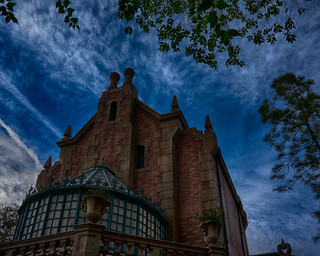 |
| Single-exposure HDR with a back-lit subject |
My second impression was that the camera feels incredibly light compared to my Canon 7D. The feeling was odd. The NEX-6 is so light and tiny (and cheaper) compared to the Canon 7D, yet the images it produces are in many ways superior to the Canon. Sure, the kit lens isn't quite in the same class as my Canon Macro 100 mm L IS, but the camera body nails the exposure, does a fantastic job of controlling noise, and at night it hoovers up every available photon.
I recently took both my 7D and the NEX-6 on a hike. The 7D spent most of the time in my camera bag, while my NEX-6 took about 80 photos. When I did take out the 7D with the 8-15mm fisheye lens, it felt like a cannonball in my hands. The additional weight of the dSLR over the NEX-6 really adds up on a long hike.
While maybe not as fast as the Canon 7D, the focus speed of the NEX-6 when using phase detection is quite quick. Note though that not all lenses support phase detection. The Sigma 30 mm f 2.8 E-mount lens does not support it. Focusing using contrast detection on the NEX-6 feels quicker than that offered by the 7D in live-view mode, but not nearly as quick as phase detection enables.
The 16-50mm f/3.5-5.6 Power Zoom Lens which ships with the camera is an unusual beast. He collapses like an old pirate telescope when switched off, and takes a second or two to extend before he is usable for taking a photo. Since the camera seems to require the same amount of time to get ready, maybe this isn't a big deal. The size of the lens when collapsed is quite reasonable.
The lens has both a zoom ring and a zoom switch. Since the zooming of the lens is actuated by motors inside the lens, either solution works. The ring seems too offer better control and speed, but the switch sometimes comes in handy when I'm holding something in my hand. I can just move the switch with my left thumb. I think some folks have complained about the speed of zooming with this lens, but I find it to be quick enough.
This lens has no focus ring. Instead, the same ring used for zooming can provide focus input when the shutter release is held half way down.
The image quality of this lens is unusual. The Sony NEX-6 has built-in correction of vignetting, distortion, and I believe chromatic aberration. If you shoot RAW, Adobe Lightroom 4 can correct the same defects automatically with the touch of a button. This feature has allowed Sony to ship this lens with what would otherwise be crippling vignetting. You can see it in the corners of the photo below.
The 16-50mm f/3.5-5.6 Power Zoom Lens which ships with the camera is an unusual beast. He collapses like an old pirate telescope when switched off, and takes a second or two to extend before he is usable for taking a photo. Since the camera seems to require the same amount of time to get ready, maybe this isn't a big deal. The size of the lens when collapsed is quite reasonable.
The lens has both a zoom ring and a zoom switch. Since the zooming of the lens is actuated by motors inside the lens, either solution works. The ring seems too offer better control and speed, but the switch sometimes comes in handy when I'm holding something in my hand. I can just move the switch with my left thumb. I think some folks have complained about the speed of zooming with this lens, but I find it to be quick enough.
This lens has no focus ring. Instead, the same ring used for zooming can provide focus input when the shutter release is held half way down.
The image quality of this lens is unusual. The Sony NEX-6 has built-in correction of vignetting, distortion, and I believe chromatic aberration. If you shoot RAW, Adobe Lightroom 4 can correct the same defects automatically with the touch of a button. This feature has allowed Sony to ship this lens with what would otherwise be crippling vignetting. You can see it in the corners of the photo below.
 |
| Hill country without correcting for lens defects |
Correcting the defects using Lightrooms profiles also means throwing a few pixels away along the edges. See the corrected photo below.
 |
| Hill Country correcting for lens defects |
The corrected images look pretty good. I imagine that most folks will just use the corrected version and not worry about it. Note that the images above were edited with slightly different settings in Silver Efx Pro
On the User Experience of dSLRs
After spending a few days with the NEX-6, I've noticed some areas where it compares unfavorably to most dSLRs. For those unfamiliar with modern dSLRs, even when they're on, they pretty much do nothing until you push a button. You can put the view finder to your face, zoom the lens, and usually even manually focus without the camera even really noticing. As soon as you touch the shutter button, the device instantly springs to life. Image stabilization activates, the exposure is metered, and the lens focuses in a fraction of a second. Unless the lens cap is on, or the batteries run dry, a dSLR user is pretty much always ready to capture an image.
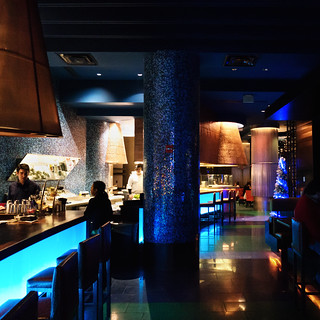 |
| Shooting the NEX-6 in a dark restaurant handheld |
The Sony NEX-6, especially with the power zoom kit lens, takes time to turn on and to extend the lens. If a UFO lands in your back yard, counts to two-mississippi and flies away, you won't get any photos with your NEX-6 unless it was awake before the aliens taunted you. Even with a prime lens, like the E-Mount Sigma 30 mm f 2.8 lens I purchased with the camera, it still takes precious seconds for the camera to wake up.
This means that you may wish to keep the camera out of power-saving mode. Except, unlike a dSLR, the camera uses the battery to keep it ready to shoot. The battery level drops noticeably as you use the NEX-6 throughout a day. I have heard that the electronic viewfinder hogs more power than the rear display, so how you use the camera might impact the battery usage.
The batteries on a dSLR last an amazingly long time. Perhaps my perception is a bit inflated because the 7D displays the battery level in 25% increments while you feel the pain as the NEX-6 visibly sheds each percentage point of charge.
The batteries on a dSLR last an amazingly long time. Perhaps my perception is a bit inflated because the 7D displays the battery level in 25% increments while you feel the pain as the NEX-6 visibly sheds each percentage point of charge.
I haven't used the camera enough to know if a full battery charge is enough to get though a very active day or not. I can tell you that the battery got dangerously close to 0% in New Orleans, but I made 480 exposures and had not charged it much that trip.
One very convenient feature of the NEX-6 is that it charges with a micro USB cable. When I travel, my laptop becomes a charging hub for my phone and now it can do the same for my camera. Nice!
Unfortunately, the charging system has a major flaw. The camera won't charge if the camera is too warm. Despite the cold weather, I have noticed more than one occasion where I though the camera was charging, but instead the camera was flashing a tiny light to let me know that it was too warm to charge. Sadly, the camera doesn't seem to monitor the temperature situation to see if it improves. More than once I have plugged the camera in for an hour and then later discovered that the light was blinking. It didn't appear that the battery had charged at all. When I unplugged the camera in this state and immediately plugged it back in, the camera began charging. This behavior implies that it doesn't automatically take advantage of a drop in temperature after it was initially plugged in.
Another difference between the NEX-6 and SLRs is durability. In all my years of not-so-gently using Canon SLRs, I don't believe I've ever had a piece of the camera fall off in normal use. For the NEX-6, I lost the rubber eye cup for the viewfinder while walking around the Magic Kingdom. I think I owned the camera 3 or 4 days. Perhaps Sony hadn't designed the camera to be carried upside-down on a Black Rapid strap, but I still felt pretty disappointed. The eye cup for the NEX-6 snaps on, while the eye cups for Canon dSLRs slides onto a track and locks. It requires a decent squeeze to slide the eye cup off a 7D. The replacement NEX-6 eye cup cost me $9.99 on Amazon.
Not to dwell on the eyecup, but I find that it adds a significant amount of depth to the NEX-6's dimensions. It really sticks out, and it works with the lens to add another obstruction to slipping the camera into a case. I hope that Sony will improve the design to be a bit more rounded in future cameras. On the bright side, the smaller NEX-6 still is far easier to stow than any dSLR.
I don't believe that the NEX-6 has any weather sealing like the Canon 7D does. I will avoid carrying the NEX-6 in the harsher environments my 7D joined me in. That said, the NEX-6 is far easier to stuff into a waterproof pocket than the bulky 7D.
The physical buttons on the NEX-6 disappoint compared to my 7D. The shutter release button on the 7D has long travel and very distinct tactile feedback when the button goes from focus mode to shutter release. The shutter release on the NEX-6 feels like mush all the way. I sometimes take photos when I mean to start the autofocus. I wish I could make one of the rear buttons on the NEX act as a autofocus button, like I could for the 7D.
 |
| A photo of the NEX-6 viewfinder with focus peaking visible as the red outline on the right side of the frog |
The one major spot where the NEX-6 smashes my 7D is in the area of predicting the outcome of a shot. Looking through the optical viewfinder, you can't tell if parts of the image will be over or underexposed for a particular shot; they're really only good for framing and focusing. Similarly, you won't have a great idea of how the colors and contrast will convey. You can guess, but you won't know. The relatively high resolution electronic viewfinder of the NEX-6 offers an excellent preview of the image you'll see when you hit the shutter.
Even better, you can configure the NEX-6 to zoom in to a particular region of the viewfinder image when manually focusing. I love the focus zoom. As long as the focus spot is configured where you'd like it, the feature makes focusing quick and confidence-inspiring. If you need to move the focus spot for manual or automatic focus, the process seems a lot faster on the 7D: push one button, move to one of the limited focus spots, and shoot.
The NEX-6 also offers focus peaking. Focus peaking colors the borders of things which are in focus (see the red borders in the photo through the viewfinder above). I initially thought this was a huge selling point for the camera, but in practice, I'm not sure I use it very much. Perhaps I would if I used a manual focus lens or shot video. The peaking seems to rely on high-contrast image areas, so certain scenes might be in focus but show little or no peaking.
When you're shooting RAW, the image you see in the view finder matches the image you'll see when you review the photo, which matches what you see in Lightroom. And those images generally look good out of the camera. I still edit them, but they don't look flat and lifeless without editing like they do for some dSLRs.
As you can see in the photo of the NEX-6 viewfinder, there are lots of nice overlays you can add. Here you can see framing guides, the green auto-focus lock rectangles, and the digital level which helps me avoid unintentionally slanty photos.
As you can see in the photo of the NEX-6 viewfinder, there are lots of nice overlays you can add. Here you can see framing guides, the green auto-focus lock rectangles, and the digital level which helps me avoid unintentionally slanty photos.
One final note about the 7D, and dSLRs in general. Although the 7D has tons of menus and complicated configuration screens, in general touching the shutter button will return the camera instantly to shooting mode. The intimidating number of buttons that cover the 7D act as dedicated controls to configure the exposure, the focus points, the iso, the white balance, the continuous shooting, and so on. The NEX-6 will sometimes have a corresponding button, but it will also sometimes disable the corresponding functionality depending on what mode the camera is in. For instance, I'm not sure why the "intelligent" modes won't let the user manually specify a focus point, if even for only one exposure. These sorts of issues and complexities can waste precious moments and might cost you a shot.
My advice for professional shooters who live and die by capturing a moment with their photography is to keep shooting dSLRs. The NEX-6 is amazing, but the reliability, durability, and ready-to-shoot nature of dSLRs will help keep you from missing shots. That said, you might find a NEX-6 useful as a third camera for making social-media-ready photos with minimal editing.
Apps
The app side of the NEX-6 fascinates me. Sony runs an app store for the NEX-6 and NEX-5R cameras. Some of the apps are free, some of them are paid. The most expensive app is the $9.99 Time-lapse app.
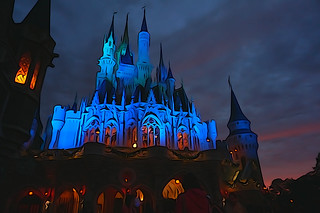 |
| The Illustration effect applied to Cinderella's Castle |
One of the more interesting apps is the free Picture Effect+ app. Picture Effect+ lets the user choose an effect to be applied after a photo is taken (it doesn't seem to let you process an existing photo, which is a shame). Some of the Effects give a real-time view of the effect, like the Partial Color+ effect which lets you select one or two colors to keep while rendering the rest of the image in Black & White. Others, like the charming Illustration effect (click on the image above) are only applied after the image is captured.
The apps do change the functionality of the camera while they are active. While the Picture Effect+ app lets you change the mode (e.g., aperture priority, shutter priority), many other settings are not available. The use of the camera can also shift in unexpected ways. For instance, the DMF mode (which changes the zoom ring to a focus ring when the shutter is partially held down) no longer zooms into the focus area when that app is loaded. Also, the menu moves to the lower button next to the display rather than the upper button (which becomes an exit button).
The changes the apps make to the interface don't ruin the functionality, but they can slow you down. I wish Sony would standardize the uses of the soft buttons a bit more. As you might expect, RAW output is disabled for this app.
The changes the apps make to the interface don't ruin the functionality, but they can slow you down. I wish Sony would standardize the uses of the soft buttons a bit more. As you might expect, RAW output is disabled for this app.
Some of the apps have questionable utility. The Bracket Pro app sounds like it would be useful for HDR, but it only seems to support the same three exposures that the camera has as built in capability. It does offer features which might not be built in, like focus bracketing (changing the focus for three exposures), and taking a photo with and without flash enabled. Perhaps it also allows more than there stops of bracketing? This app costs $4.99.
I think Sony has lots of room to improve here. I would definitely like to see an SDK so that third parties could develop apps (what a shame the OS isn't Android based!). I would also like to see more clarity of exactly what the capabilities of the apps are and how they differ from the camera's built-in functionality. I would also like to see comments and reviews from users so I can get some idea of how useful an app is before I buy it.
Still, especially for quickly making an interesting image for social media, apps seem promising. I hope to see more apps in the future.
Smart Phone Integration
Sony offers PlayMemories Mobile apps for the Android and iOS which promise to allow the user to send photos from the NEX-6 to a smart phone or tablet. I really love this idea, but I hate the PlayMemories Mobile app.
To send a photo from the NEX-6 to an Android phone wouldn't be bad if the Android app worked. The user simply needs to find the photo of interest, hit the menu button, select Playback, and then select View on Smartphone. The camera will wait while you run the PlayMemories Mobile app on the Android device. The app will see the NEX-6 on WiFi, let you select it and (with some initial configuration for password and so on), and then you'll see a preview of the image you selected on the NEX-6.
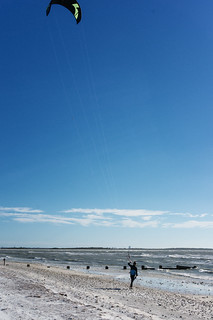 |
| Outdoors on a sunny afternoon with the NEX-6 |
From there, you can try to "Copy" or "Upload" the photo. If the author or translator of those descriptions was familiar with using Android in English, they probably would have labeled the buttons "Save to Gallery" and "Share".
Unfortunately, you will feel frustrated if you try either of those button. Every time I've tried to transfer the photo, I see a progress bar that reaches the end but the process never finishes. The app just hangs indefinitely while the batteries of your phone and camera slowly drain. If you exit the sharing mode on the NEX-6 and are lucky, you may discover that the photo did transfer to your Gallery in a dedicated PlayMemories Mobile folder. The poor design and execution of the android app makes me want to tear my hair out.
The same android app can also act as a remote control if you run the Smart Remote Control app on the NEX-6. If you can get the Android app to connect (sometimes it takes a second or third try), it offers a live view of what the camera sees, a shutter release button, and in some camera modes (like aperture priority) it allows the user to change the exposure compensation by going through an inconvenient menu. Users can slowly adjust the exposure by moving in 1/3 stop increments and waiting while the camera updates. After the user hits OK, the shutter release button returns to the screen.
Sadly, the Smart Remote Control app doesn't seem to support certain shooting modes, like the i+ mode. The PlayMemories MobileAndroid app doesn't communicate what the problem is, but the back of the camera offers users a poorly worded clue. If the user rotates the mode dial to a supported mode, the remote app will start working. Hopefully you haven't mounted your camera to a hang glider and jumped from a cliff before you discover this problem.
Hitting the shutter release button on the Android app will trigger the camera to shoot a photo about a second later. Sports photographers won't find the app very useful with such a long shutter lag.
 |
| 10 FPS bursts help you capture the moment this man jumps over six people |
Hitting the shutter release button on the Android app will trigger the camera to shoot a photo about a second later. Sports photographers won't find the app very useful with such a long shutter lag.
It isn't clear to me if the remote control app allows the user to change the focus. Sometimes focus seemed to change in response to my taps, but I think that was just coincidence. The camera seems to be periodically auto-focusing itself. There are no controls to change zoom from the app.
I tried the iOS version of the PlayMemories Mobile app on my third generation iPad. In some ways it was better and others worse than the Android app. Unlike the Android app, even after setting up the WiFi password of the NEX-6, the iOS PlayMemories App won't automatically connect to the camera. Instead, the user is told (with nearly indecipherable instructions) to go to the iOS Settings app and connect the device manually to the NEX-6's WiFi network. Yes, the user has to disconnect from a WiFi network that might be providing internet access, and connect to the camera's ad-hoc wifi network. Once the connection completes (which takes several seconds), the user can return to the app and it will communicate with the camera. The interface looks very similar to the Android app: bare bones.
Unlike the Android app, an image sent from the NEX-6 will rapidly transfer off the device and it doesn't hang indefinitely. Like the Android app, the user can change the settings (from the iOS Settings app in this case) to download either 2 megapixel or full-resolution images to the iOS device.
Using the Smart Remote Control app with iOS again requires that the user connects to the NEX-6's WiFi network. It's behavior otherwise is very similar to the Android app: the view updates fairly rapidly, but the lag from pushing the shutter button until the photo is taken is an unimpressive 1 second or so.
To sum up, the iOS and Android apps both pain me to use. I can hardly believe how frustrating and ugly the apps are on the two largest smartphone platforms! They provide useful functionality if you can persuade them to work and guess your way through the interface, but you probably won't like them. My dream of sending lots of NEX-6 photos to Instagram while I'm on the road has not come true.
Sony should be embarrassed, but I'm not sure they care. I know several mobile developers who could make a much better app from scratch in mere weeks, so I'm pretty sure that fixing the product is possible. It seems as if Sony doesn't believe that software or user experience matters. They must have put so much work into the camera's amazing image processing and scene detection software. How could they have given up when it came time to build a fantastic user experience around it?
Can you imagine if Ferrari shipped a high performance coupe with a plastic tiller for steering? Nobody would believe that even the most stripped-down economy car could ship with a steering system adopted from a small sailboat. And yet Sony expects me to use an app that feels like junk-ware from a 1990s PC to get photos on to my phone. A small child could tell you that you put steering wheels in cars. The same small child could probably tell you that the PlayMemories Mobile app needs to successfully download photos and quickly react to touches.
I really hope that Sony puts some serious development and design effort into improving the Android and iOS experience. The vision behind the NEX-6 is fantastic, but the execution stinks. If Sony wants to take a leadership position in the camera market, it needs to hire some serious interface designers, user experience experts, and software developers. And then Sony needs to make a cultural shift to put user experience ahead of dorky feature checkboxes.
I bet some VP in the camera division of Sony must still be using a candy bar phone with a touch-tone keypad on it. If you're that guy, you better run to a store right now and buy a state-of-the-art smart phone. Take it home and install twenty or thirty of the top photography apps on it. Make flickr, Instagram, Facebook, and twitter accounts. Take photos, edit, and share them. Now try to do the same from a NEX-6. Do that a few times, and you'll see exactly why the NEX-6 experience doesn't even meet the most basic expectations of social media users. You can fix this; you just need to understand the problem and get help.
Conclusions
The NEX-6 makes beautiful photos, is incredibly portable compared to a dSLR, and has a wonderful intelligent shooting mode which usually does a great job recognizing a scene and picking good settings. The large sensor and focus peaking allows users to reasonably use third party lenses that have E-mount adapters. I love it! The photos from this camera look wonderful.
Unfortunately, there is a lot to improve in the realm of user interface on this camera, especially its native apps, and on the Android and iOS PlayMemories Mobile apps. Actually, the out-of-the-box software on the NEX-6 is OK to use. It doesn't quite match the user experience of a 7D, but it works. But the apps need to be a little more user friendly, and the smart phone integration needs a lot of work.
Right now, the camera market is still focused on the imaging side of the equation. Maybe Sony still has time to get to an experience that will satisfy the App Generation. Right now there probably isn't some competitor out there that is doing any of this software stuff right yet. But soon there will be.
Right now, the camera market is still focused on the imaging side of the equation. Maybe Sony still has time to get to an experience that will satisfy the App Generation. Right now there probably isn't some competitor out there that is doing any of this software stuff right yet. But soon there will be.
I really hope that Sony puts in some effort to improving the software, because I think the potential for EVIL cameras with smart phone integration is huge. The first company to really do this well should dominate the market for high-end consumer cameras, and perhaps the professional market too.
Despite my disappointment with the current state of the software, I plan to use this camera a lot. Sometimes my Canon 7D will be my primary shooter because I'll want the speed and reliability and user experience. Frequently I expect that my Canon will stay at home and the NEX-6 will be my camera of choice on the road. Who wants to carry around the weight of the 7D unless they have to?
I'll be keeping my eyes out for a similar camera that has better integration with smart phones and better software.
What I love about the NEX-6
- Captures blue skies while still exposing rest of image properly
- Intelligent mode detects the type of scene and does a great job picking settings more often than not
- Images from the kit lens look really nice after Lightroom automatically corrects distortion and vignetting
- The body has an understated look that does not call attention to itself as a "professional" camera
- Zooming responds quickly on the kit lens even though it is electronic, and not a direct physical connection in this lens
- Manual focus is easy with the automatic 100% view
- Phase detect autofocus is generally fast, and works in fairly low light
- Articulated screen is quite useful for getting interesting camera angles
- There are third party lenses available, and adapters for lenses on other systems
- Even in low light, the camera still captures great detail and good dynamic range
- The bottom of the articulated rear screen is slightly recessed so it is possible to use it on a tripod
What I disliked about the NEX-6
- Eyecup may fall off if bumped
- Android and iOS apps disappoint
- On-camera apps are sometimes slow to load, and confusing to operate
- Some on-camera apps don't seem to allow you to apply effects to an existing photo
- Can't use some on-camera functions or apps and save RAW files
- Latency when turning the camera on and waking seems slow
- Battery life could be an issue for heavy shooting
- The camera won't charge the battery if it thinks it's too hot when you plug it in
- UI can be slow or confusing to use
- No secondary button can be assigned to autofocus
- Camera may not go to sleep if something (like your shirt) near the electronic view finder triggers the eye detection
- The phase-detection auto focus only works with certain lenses (my Sigma 30 mm does not seem to be one)
- The camera sometimes autofocuses even if the shutter button isn't held down. This is usually helpful, but it can also confound your ability to reframe a shot with the same focus
- The articulating screen isn't quite recessed enough to keep from rubbing against the pad on my +Peak Design ARCAplate (the screen still can be adjusted with a little force; I should probably get a MICROplate)
*Moving Average Inc. is a participant in the Amazon Services LLC Associates Program, an affiliate advertising program designed to provide a means for sites to earn advertising fees by advertising and linking to amazon.com. Buying items through this link is much appreciated!
